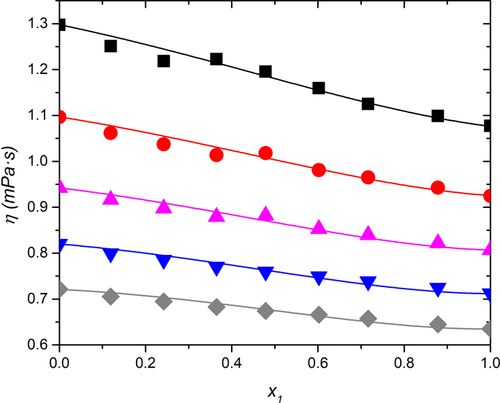当前位置:
X-MOL 学术
›
J. Chem. Eng. Data
›
论文详情
Our official English website, www.x-mol.net, welcomes your
feedback! (Note: you will need to create a separate account there.)
Density and Viscosity of Binary Mixtures Composed of Anisole with Dodecane, Hexadecane, Decalin, or 1,4-Dioxane: Experiments and Modeling
Journal of Chemical & Engineering Data ( IF 2.0 ) Pub Date : 2020-03-20 , DOI: 10.1021/acs.jced.9b01159 Nicolás F. Gajardo-Parra 1 , Matías I. Campos-Franzani 1, 2 , Ariel Hernández 3 , Néstor Escalona 1, 2, 4, 5 , Roberto I. Canales 1, 2
Journal of Chemical & Engineering Data ( IF 2.0 ) Pub Date : 2020-03-20 , DOI: 10.1021/acs.jced.9b01159 Nicolás F. Gajardo-Parra 1 , Matías I. Campos-Franzani 1, 2 , Ariel Hernández 3 , Néstor Escalona 1, 2, 4, 5 , Roberto I. Canales 1, 2
Affiliation

|
Anisole is an important lignin derivative used as an intermediate for obtaining high-value-added molecules through heterogeneous catalysis. Typical solvents used in the catalytic conversion of anisole, and other model molecules of the chemical platform of lignocellulosic biomass, are dodecane, hexadecane, decalin, and 1,4-dioxane. To understand the interactions of anisole with the different solvents and the transport properties of those mixtures, the density, viscosity, and miscibility of anisole + solvent systems are very important parameters for a first-step study of their behavior. This information is relevant for future studies on the separation of anisole from the biomass-processing platform. Then, the density and viscosity are measured for pure anisole and the four pure solvents, i.e., dodecane, hexadecane, decalin, and 1,4-dioxane, and the binary mixtures composed of anisole + solvent. The temperature range for all measurements is from 293.15 to 333.15 K at 101.3 kPa. Excess volumes are calculated from the density of mixtures, obtaining a positive deviation from ideality for all binary systems. The density of mixtures and excess volumes are modeled using the Peng–Robinson equation of state with the modified Huron–Vidal mixing rule using the nonrandom two-liquid model for calculating the excess Gibbs free energy. The viscosity of the mixtures is modeled with the same combination of the equation of state and mixing rule coupled to the friction theory viscosity model. The density of the mixtures is modeled with average absolute deviations ranging from 0.59 to 11.75%, excess volume from 0.8 to 35.4%, and viscosity of the mixtures from 0.1 to 13.2%.
中文翻译:

苯甲醚与十二烷,十六烷,十氢化萘或1,4-二恶烷组成的二元混合物的密度和粘度:实验和建模
茴香醚是一种重要的木质素衍生物,用作通过多相催化获得高附加值分子的中间体。在苯甲醚和木质纤维素生物质化学平台的其他模型分子的催化转化中使用的典型溶剂是十二烷,十六烷,十氢化萘和1,4-二恶烷。要了解苯甲醚与不同溶剂的相互作用以及这些混合物的传输特性,苯甲醚+溶剂系统的密度,粘度和可混溶性是第一步研究其行为的重要参数。该信息与未来从生物质处理平台分离茴香醚的研究有关。然后,测量纯苯甲醚和四种纯溶剂(即十二烷,十六烷,十氢化萘和1,4-二恶烷)的密度和粘度,以及由苯甲醚+溶剂组成的二元混合物。所有测量的温度范围均为101.3 kPa,从293.15至333.15K。从混合物的密度计算出多余的体积,对于所有二元系统,其与理想值的偏差都为正值。混合物的密度和多余的体积使用Peng-Robinson状态方程和修正的Huron-Vidal混合规则建模,并使用非随机两液模型计算多余的吉布斯自由能。用状态方程和混合规则的相同组合结合摩擦理论粘度模型对混合物的粘度进行建模。对混合物的密度建模,其平均绝对偏差为0.59至11.75%,过量体积为0.8至35.4%,混合物的粘度为0.1至13.2%。
更新日期:2020-04-24
中文翻译:

苯甲醚与十二烷,十六烷,十氢化萘或1,4-二恶烷组成的二元混合物的密度和粘度:实验和建模
茴香醚是一种重要的木质素衍生物,用作通过多相催化获得高附加值分子的中间体。在苯甲醚和木质纤维素生物质化学平台的其他模型分子的催化转化中使用的典型溶剂是十二烷,十六烷,十氢化萘和1,4-二恶烷。要了解苯甲醚与不同溶剂的相互作用以及这些混合物的传输特性,苯甲醚+溶剂系统的密度,粘度和可混溶性是第一步研究其行为的重要参数。该信息与未来从生物质处理平台分离茴香醚的研究有关。然后,测量纯苯甲醚和四种纯溶剂(即十二烷,十六烷,十氢化萘和1,4-二恶烷)的密度和粘度,以及由苯甲醚+溶剂组成的二元混合物。所有测量的温度范围均为101.3 kPa,从293.15至333.15K。从混合物的密度计算出多余的体积,对于所有二元系统,其与理想值的偏差都为正值。混合物的密度和多余的体积使用Peng-Robinson状态方程和修正的Huron-Vidal混合规则建模,并使用非随机两液模型计算多余的吉布斯自由能。用状态方程和混合规则的相同组合结合摩擦理论粘度模型对混合物的粘度进行建模。对混合物的密度建模,其平均绝对偏差为0.59至11.75%,过量体积为0.8至35.4%,混合物的粘度为0.1至13.2%。











































 京公网安备 11010802027423号
京公网安备 11010802027423号